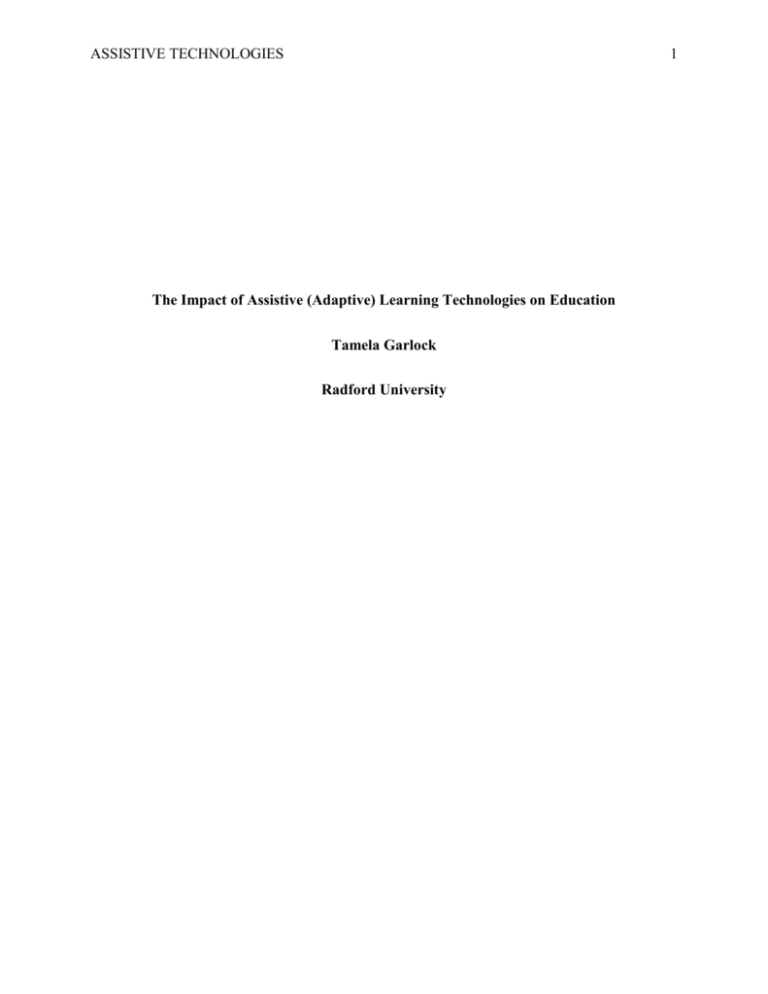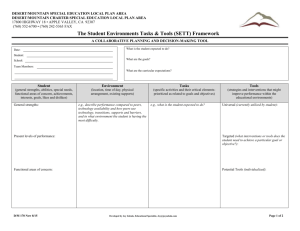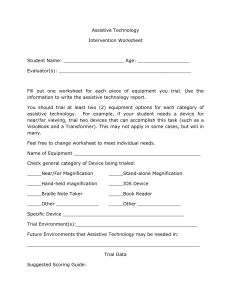File - Tamela Garlock
advertisement

ASSISTIVE TECHNOLOGIES 1 The Impact of Assistive (Adaptive) Learning Technologies on Education Tamela Garlock Radford University ASSISTIVE TECHNOLOGIES 2 The Impact of Assistive (Adaptive) Learning Technologies on Education Introduction: Assistive technologies, also known as adaptive technologies, open doors for many capable learners and have a direct impact on their quality of life. These technologies give a voice to those who have none; give mobility and access to facilities to those who can’t move independently. Without assistive technologies, many students would not be able to achieve their full potential. Take a moment to imagine yourself with an intellectual disability that makes it difficult if not impossible for you to express your needs or demonstrate understanding. Imagine how frustrated you would be without the ability to communicate. Over time, this frustration may grow into feelings of anger, alienation and sadness. Imagine yourself unable to move about independently. You would not be able to participate in everyday activities. Over time, this lack of mobility would also lead to frustration and negative feelings. You would feel like an outsider looking in, watching others participate in a life you are denied. Students who endure daily the experiences you just imagined also struggle in the school environment. Assistive technologies can help students acclimate in a classroom without feeling like an outsider and overcome obstacles that affect their learning. Yet the greatest benefit is to the student’s confidence and self-worth. When students are successful in an educational environment they may become successful in everyday life. Assistive Technologies make it possible for students to enjoy life by providing ways for them to participate in it. Different types of Assistive Technologies help with mobility, communication, and help students who are visually and/or hearing impaired. As a result of assistive technologies students ASSISTIVE TECHNOLOGIES 3 with disabilities are finding ways to actively participate in physical activities at school and in classroom instruction. My students will benefit greatly from assistive technologies that help narrow the achievement gap and allow them to effectively participate in classroom instruction, lectures, and discussions. As a teacher of students with special needs, I am honored to be part of a team that helps students meet and overcome different challenges every day. My current students benefit greatly from assistive technology devices. Therefore, choosing assistive technologies as a research topic was an obvious decision. The students I teach face a variety of challenges. Some of my students have physical disabilities, some have intellectual disabilities or delays, and some have both physical and intellectual delays. The assistive technologies used by my students have a great impact on the way they access, learn and share information in the classroom setting. In this literature review you will find examples of assistive technologies, different devices and their usage. You will discover how the different devices impact the student’s everyday quality of life and their learning. Learning how the assistive technologies have become more effective for student learning will also help one understand that as more and more technological advances are made, more modifications and adaptations of the devices are also created to make these devices more efficient. Information regarding how the devices are used and who will teach the students how to use the devices will be provided. Information regarding teacher roles, methods to deliver instructional information and teacher expectations for student use of the different assistive technologies will also be provided. Results from case studies, and student successes will be discussed throughout this paper. ASSISTIVE TECHNOLOGIES 4 The people who benefit most from these devices will be obvious. Assistive technologies provide more opportunities for students with special needs to be part of community learning by giving them the ability to access the information and participate in a meaningful way with all students in the learning environment. Assistive technologies help create learning environments where special needs students and other students learn together and this benefits all students. What is Assistive Technology? Wikipedia defines assistive technology as any device made commercially or custom modified that is designed to enhance, increase, maintain or improve functionality of a person with a disability. Medical devices are not considered part of assistive technology. Assistive technology services are any services that are given to aid the individual with a disability directly. This could include someone who helps with the assistive technology such as a person that would take notes for a student, or someone who helps a student use their wheelchair, communication device and such. Research Supporting Assistive Technology Research from The Department of Veteran’s Affairs provided information about how assistive technologies help everyday activities and give individualized value to each person’s ability to maintain lifestyles, and gain more independence. The purpose of the research study was to examine how the technology influences one’s quality of life. The study focused on how veterans would cope without their assistive technology, and whether their quality of life is affected. The studies concluded that in order to integrate the technology successfully in everyday life situations, the individual using the technology must buy into the usefulness and purpose of the devices. The assistive technology influenced the social interactions by eliminating the barriers that kept them from participating, an example would be the orthopedic device that would ASSISTIVE TECHNOLOGIES 5 help mobility and let them participate in a game of ball with his or her friends. Another benefit of the technology is that it helps the individual and others understand a person is more than just the sum of their disabilities. The disability is only one part of the person (Louise-Bender P., Kim,J., Weiner, B. 2002). The next article reviewed discussed the “culture” of the disability and the assistive technologies, how they are inner twined (Ripat, J. Woodgate, R. 2010). The article suggests that the disability and the use of the technology become part of the individual’s identity. As an example, this study provides insight to how the deaf view assistive technology. Those who are born deaf or become deaf at an early age often view their deafness as a part of their culture and do not embrace the use of assistive technologies. Their deafness is a part of their individuality and they adhere to deaf cultural expectations. However, those who lose their hearing after being exposed to the hearing world view their deafness as a disability and not a part of their culture. This latter group embraces the use of assistive technologies to aid their hearing. Technologies and instruction should always respect the diverse needs of the individual while keeping their beliefs and individuality in mind. Another interesting assistive technology, assistive robotics, will influence the lives of individuals with disabilities. (Brose, S., Weber, D., Sallitan, B., Grindle, G. Wang, H., Vazquez, J, and Cooper, R., 2010). This study focused on improving quality of life and fostering independence through the use of robotics. The objective of this research was to establish baseline data to determine validity of the assistive technology and how the best match for each individual is determined. After the six steps of the study are completed, benefits to using robotics were found. As technology evolves more data can support how best to use this technology appropriately. These could indeed be robotic arms, or legs. ASSISTIVE TECHNOLOGIES 6 Research will need to be developed in order to keep up with the vastly growing technological advances. The flaw in research may be implementing the use of newer devices without revisiting old school assistive devices that we already know work. An example of this would be to evaluate the efficacy of a communication board where the student will use pictures to communicate in comparison to an application on an IPad that will speak for the student. Having a student make utterances and pointing to wants and needs using the communication board compared to just swiping a picture that will say the word for the student may make the communication faster but limit the student’s verbal interaction with other people and may hinder growth. Another problem that may occur is a student’s total dependence on the assistive technology. As long as the technology is available the student is able to communicate their wants and needs or move about freely. However, should the device fail the student’s ability to adjust without it and still have their needs met may not be possible. An example would be a battery malfunction on a student’s electric scooter. If the scooter is the student’s only means of mobility and a malfunction occurs, the student’s access to the classroom, hallways, restroom, lunchroom and home would be in jeopardy. Types of Assistive Technologies Used in Education When you consider using technologies in education, two aspects, quality and quantity, need to be examined. The first question one must answer is, will the technology improve the students’ life and educational outcome (Quality)? Second, how much assistive technology may be too much or is it, the more the merrier? (Quantitative). An example of quality technology is a wheelchair to help in mobility. An example of quantitative technology would be a student who receives an augmented communication device and also uses a hearing device in order to hear ASSISTIVE TECHNOLOGIES 7 instruction. Both of these examples would benefit the student and would not be considered too much. Students with physical disabilities affecting their mobility may use aids. Depending on the severity of their lack of mobility the students could use a number of technologies that include wheelchairs, scooters, walkers, canes, crutches, prosthetics, and orthotics. These technologies can provide students a way to access areas in the classroom and other areas of the school and allow them to participate and interact more with their peers (De Joode, E., van Heugten, C., Verhey, F., & van Boxtel, M. 2010). Computers, IPad and tablets along with computer software and hardware also enhance student learning and aid their mobility. These could include voice activated programs, and voice recognition programs. The technology that students with mobility impairments could benefit from is computer software and hardware that may help them communicate if they are unable to type or speak. For students that have a hearing impairment, hearing aids may be used to improve the student’s ability to hear lectures, listen to announcements, hear bells for transitions, and aid them in listening to peers. For students that need more cognitive assistive technologies they may benefit from computer or electric devices that would help them function after a brain injury. Assistive technologies can be as simple as an easel to elevate a book, voice recordings of other students reading, a ball to sit on during class that will allow movement and help students with attention deficits to focus. Book holders, automatic page turners, pencil grips, and colored film overlays to help in reading, are more examples of assistive technology devices that help students access information and demonstrate abilities, while actively participating in instructional activities. Additional technologies designed to help mobility and allow individuals ASSISTIVE TECHNOLOGIES 8 to participate in sporting activities are adaptive switches to help motor skills and aid in completing educational games and other activities as well as lightweight wheelchairs. Assistive Technologies Help Student Increase Student Learning “Assistive Technology: Enhanced Learning for All,” discusses how assistive technologies have provided more options for students that have a variety of learning deficits. (Wahl, L. 2010). Assistive technologies allow individualized devices and services to be used to maximize the student’s potential. If a student has limited speech they may benefit from a communication device to help them express their ideas, wants and needs. Another way assistive technology can benefit individual students is in modifying and scaffolding instructions. An example of this would be to provide the student with an audio book if the student cannot read on grade level. This will help them access the needed information, learn the material, and understand the content and graphics meanings. A great way to help a student with dyslexia is to offer them a word processor such as an AlphaSmart word processor that allows notes to be edited at a later time. If a student does not have the skills necessary to multi task, a peer could take notes and make a copy for the other student so that he or she can listen to instruction without the distraction of note taking. Assistive technology is designed to meet the individual needs of the students and will improve their educational experiences. This can only be done effectively if educators have the training and access to the appropriate individualized technology. How Teachers Can Facilitate Uses of Assistive Technology As with everything, education plays an important role. This is no different for teachers. In order to provide individualized instruction and provide modifications and scaffolding for students, teachers will need to be skilled and informed about the available technologies provided ASSISTIVE TECHNOLOGIES 9 at their schools. Many teachers are overwhelmed with and focus on the rigorous mandated testing, and do not see the value of individualized instruction. The teachers’ focus may need to be changed. The only way to accomplish this would be to provide adequate training and support on the use of assistive technologies. This will lessen the teachers’ anxiety and will provide information about the value of the technology for the student (Cook, A., & Polgar, J. M. 2014). . Computers are now including settings such as voice activation to help students’ access information. Yet before teachers begin exploring the options available to provide students access to technology they will need to understand the needs of their students. Then they will be able to explore options that are appropriate for their students’ specific needs. Curriculum resources provides specific examples and best practices that show how the computers and IPads can be personalized for students with physical disabilities and or different learning requirements. Instruction will need to be created to ensure that effective instruction is available to all learners and is designed with the individual students’ needs in mind, Salcito suggests that this will ensure personalized learning (Salcito, A., 2015). A network of support will also help teachers find resources, share ideas and find available training for their curriculum. This will also give them an opportunity to learn more about different learning styles and different needs of students. Early intervention helps both the teacher and the student. Supports need to be put into place early in the school year before a lot of the curriculum is covered. Personalizing the technologies available to the student helps them understand the benefit of the assistive devices and provides them with skills that will serve them in academics, home life, and later in the work force. When developing lesson plans, teachers should adjust the curriculum to be the most beneficial to the student, covering content that will serve students ASSISTIVE TECHNOLOGIES 10 throughout their education and entrance into the workforce. Setting the student up for success will help not only academically, but will increase their chances to be a productive citizen. Teachers also need to consider the accessibility and costs of the technologies as well as the student’s skill level, learning styles and interest. As more and more classrooms are focusing on inclusion, students and teachers will need to plan strategies, as well as educate themselves on the available technology. The latest and greatest technology may not be available due to cost. Teachers may reach out to companies for a grant to gain access to these devices. Teachers will need to research available technology and whether or not their system supports the use of the technology. Providing technology that best meets individual needs will change how most teachers in regular classrooms teach. Every student has strengths and needs, it is up to the teacher to find a way to showcase the strength and then provide assistance for the area of need. An example of this would be to showcase a child’s interest in history (strength) while providing an audio book on the history subject to be discussed (reading processing problem) (Hutinger, P. 1996). As teachers see positive results in their students’ lives and academic outcomes, the teachers will likely continue to find assistive technologies for their students and may even add to the technologies already created. Teachers who believe in and support the use of assistive technologies foster a feeling of validation in their students and encourage them to be a bigger part of the learning community. Conclusion: Assistive Technologies will be a crucial part of my students’ future. As stated above technology has not only provided a catalyst for students to be able to narrow the achievement gap it has increased their peer interactions. This interaction provides increased opportunities to ASSISTIVE TECHNOLOGIES 11 gain acceptance from peers, provides more ways for students to gain independence and gain confidence. Students must feel independent and confident if they are to successfully navigate their changing environment in and out of the school setting. As these literature reviews reveal, assistive technology has not only helped improve student academics and mobility but has provided more inclusion and acceptance. These technologies have provided individualized learning opportunities that value the child by focusing on their abilities not their disabilities. Assistive technologies will continue to evolve as more and more advances are made in the technology field. In order to have conclusive research, researchers will be faced with the huge task of keeping up with the latest trends and inventive devices as well as comparing the effectiveness with the old and new assistive technologies. These technologies provide each student with a disability a way to be known as a thinker, an athlete, or a writer, not just a student in a wheelchair or a student with a visual or hearing impairment. As more technology aids are introduced and used in inclusion settings, student selfworth will also increase. Allowing students with and without disabilities to access the assistive technology will not only foster a sense of community, it will also lesson the stigma of assistive devices and the stigma of having a disability. ASSISTIVE TECHNOLOGIES 12 References: Brose, S., Weber, D., Sallitan, B., Grindle, G. Wang, H., Vazquez, J, and Cooper, R. American Journal of Physical Medicine Rehabilitation, The role of assistive robotics in the lives of persons with disability, 2010. 89(6):509-21. Cook, A. M., & Polgar, J. M. (2014). Assistive technologies: Principles and practice. Elsevier Health Sciences. De Joode, E., van Heugten, C., Verhey, F., & van Boxtel, M. (2010). Efficacy and usability of assistive technology for patients with cognitive deficits: A systematic review. Clinical Rehabilitation. Grönlund, Å. Lim, N., & Larsson, H. (2010). Effective use of assistive technologies for inclusive education in developing countries: Issues and challenges from two case studies. International Journal of Education and Development using ICT, 6(4), 5-26. Kukulska-Hulme, A. (2005). Mobile learning: A handbook for educators and trainers. Psychology Press. Hutinger, P. (1996). Assistive technology applications in educational programs of children with multiple disabilities: A case study report on the state of the practice. Journal of Special Education Technology, 13(1), 16-35. Kirsch, N. L., Shenton, M., Spirl, E., Rowan, J., Simpson, R., Schreckenghost, D., & LoPresti, E. F. (2004). Web-Based Assistive Technology Interventions for Cognitive Impairments ASSISTIVE TECHNOLOGIES 13 after Traumatic Brain Injury: A Selective Review and Two Case Studies. Rehabilitation Psychology, 49(3), 200. Kuipers, B. (2000). The spatial semantic hierarchy. Artificial intelligence, 119(1), 191-233. Frank- Lopresti, E., Mihailidis, A., & Kirsch, N. (2004). Assistive technology for cognitive rehabilitation: State of the art. Neuropsychological rehabilitation, 14(1-2), 5-39. Okolo, C. M., & Bouck, E. C. (2007). Research about assistive technology: 2000-2006. What have we learned? Journal of Special Education Technology, 22(3), 19. Phillips, B., & Zhao, H. (1993). Predictors of assistive technology abandonment. Assistive Technology, 5(1), 36-45. Ripat, J. Woodgate, R, The intersection of culture, disability and assistive technology. Disability Rehabilitation /Assistive Technology. 2011; 6(2), 87-96. Salcito. A., retrieved December 05, 2015 http://blogs.msdn.com/338063/ProfileUrlRedirect.ashx Wahl, L. Assistive technology: enhanced learning for all, American Journal of Physical Medicine and Rehabilitation 2010 Jun; 89(6):509-21.







